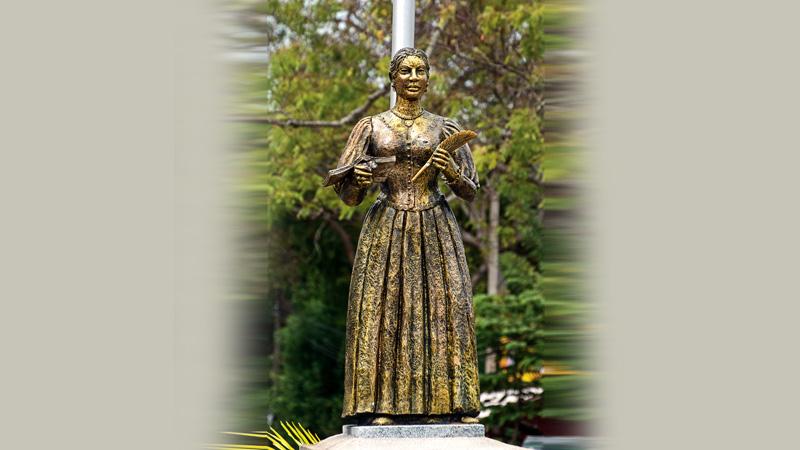
The Hambantota district, with a population of over 570,000 and once, one of Sri Lanka’s most impoverished regions, has undergone enormous change in the past decade. Not only is it steeped in history, culture, tradition, and legendary characters, endowed with sites of interest including an array of ancient temples, the famous hot wells and blow hole, but also its rapid development has led to the emergence of the country’s second international airport, the largest port besides Colombo and a giant cricket stadium where international matches are played.
 I have seen the statue of Gagaman Nona at the Nonagama junction several times during my visits to Hambantota and decided to write a piece on her when we had an opportunity to visit Matara recently.
I have seen the statue of Gagaman Nona at the Nonagama junction several times during my visits to Hambantota and decided to write a piece on her when we had an opportunity to visit Matara recently.
Many visitors to Hambantota in Southern Sri Lanka won’t fail to miss the statue of Gajaman Nona - dressed in ankle length skirt and long sleeved blouse - at the end of the Nonagama junction on the Tangalle-Hambantota road where the A2 trunk road meets the A18 highway.
Versatility
Dona Isabella Koraneliya Perumal better known as - Gajaman Nona - was one of (then) Ceylon’s most famous poets known particularly for her versatility to write and recite impromptu Sinhala kavi (poetry) in the late 18th to the early 19th century in Hambantota.
The village of Nonagama lies insignificant and almost forgotten except for its origins, a colourful tapestry wrapped around the 18th century Sri Lankan poetess Gajaman Nona. She was, perhaps, a pioneer of women’s liberation, breaking away from tradition and becoming somewhat of a controversy in a tight-knit society dominated by men.
The Dutch and the English courted her. She was a close confidant to John D’Oyly, the Sinhala speaking, Cambridge-educated British colonial administrator who is probably the best known and most remembered European of the era. At the time, D’Oyly was the British Government Agent stationed in Matara.
Gajaman Nona, twice widowed at a young age, had lost her father who had been supporting her and her three children. But she was a woman of ravishing beauty, and it is said that she often visited D’Oyly – to whom she had written a 14-verse poem – seeking assistance from the British Agent to financially sustain herself and her family. The result was Nonagama (literally ‘lady’s village’), a gift of land consisting of a few villages (known in times of Sinhala royalty as a nindagama) bestowed on Gajaman Nona by the generous young English administrator.
Students of the same teacher
The articulate Gajaman Nona was well-known and much talked about. She and John D’Oyly were pupils of the erudite bhikkhu Ven. Karatota Thera from whom D’Oyly learnt Sinhala. The poetry Gajaman wrote for D’Oyly in the native language was translated by the Englishman and sent to his mother in Britain.
As students of the same teacher, Gajaman Nona and John D’Oyly may have shared commonalities of study that would have led to many interactions.
This may have spilled beyond the accepted norms of platonic friendship. She visited him to discuss literature and assist him improving his Sinhala language skills, while proudly advertised his friendship with the local beauty.
The gifting of the land by D’Oyly to the widowed lady ignited a romantic tale between the 46-year-old Sinhala socialite and 27-year-old Englishman.
In the ultra-conservative Sinhala society of the South, such friendships between rulers and the ruled, especially involving both genders, would have irked sensibilities and raised eyebrows.
Truth and folklore
What happened between the poetess and the administrator was never really known, and in the mix of truth and folklore, falsity or fact, it was lost in the winds of time. The tale of poetry, and Sinhala conversation between the two certainly spawned rumours of lust and romance.
As the years rolled by, the legend of the gifting of ‘Nonagama became repeated from generation to generation, with, of course, the inevitable embellishments.
D’Oyly never went back to England. He made his home in Kandy, and now lies buried in the Garrison Cemetery where colonials made their last stop. The little plot overlooks the ancient hill capital, and a brown brick podium erected by his brother from Buxton tells the world where the former British official rests.
One wonders where Gajaman Nona lies in eternal sleep. The village is there, named after her, and the memoriam too, and people remember. The story told and retold, passed to someone else who in turn would speak of Gajaman Nona and D’Oyly and the land he gifted her and the poetry they shared.
May be, one day someone driving along the coastal road towards Tangalle would seek out the village, stop by the statue, and reflect for a moment, on an ancient and entirely probable love story.
